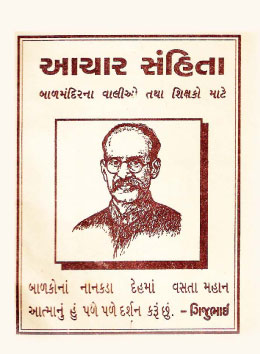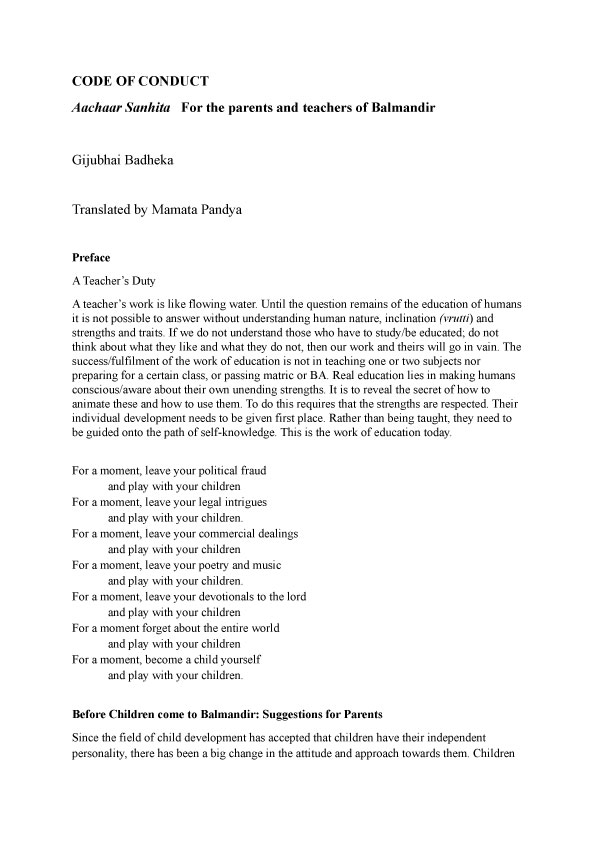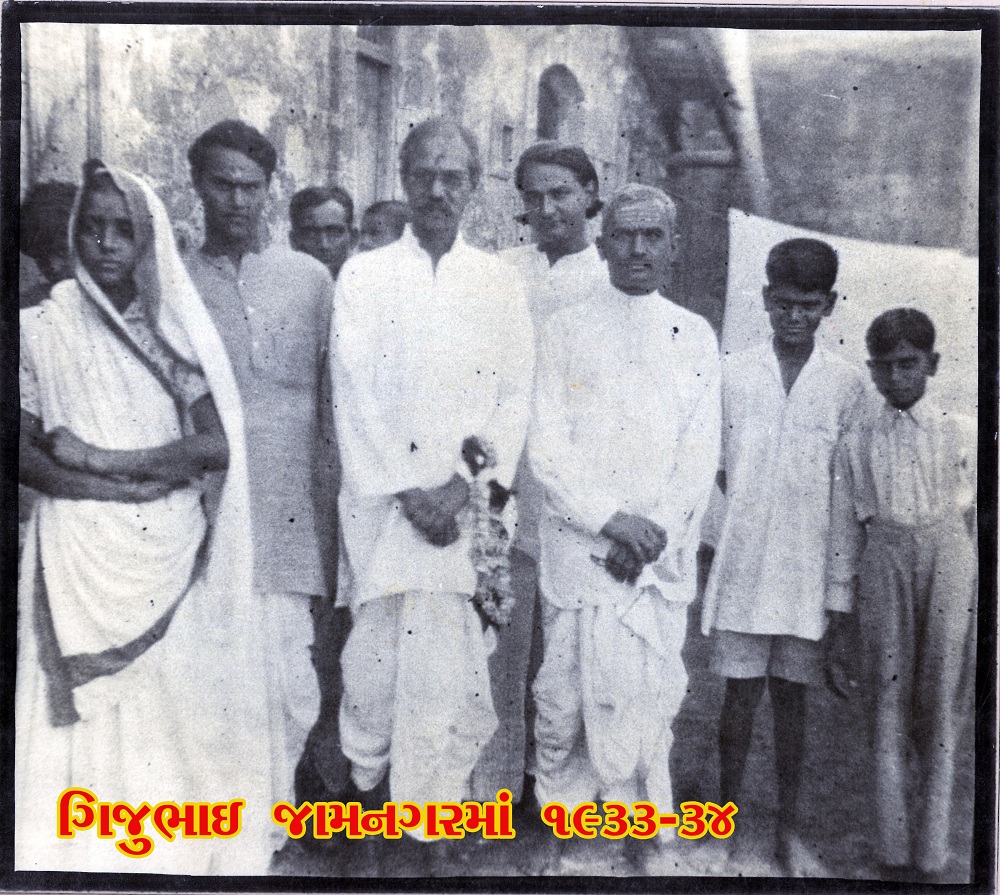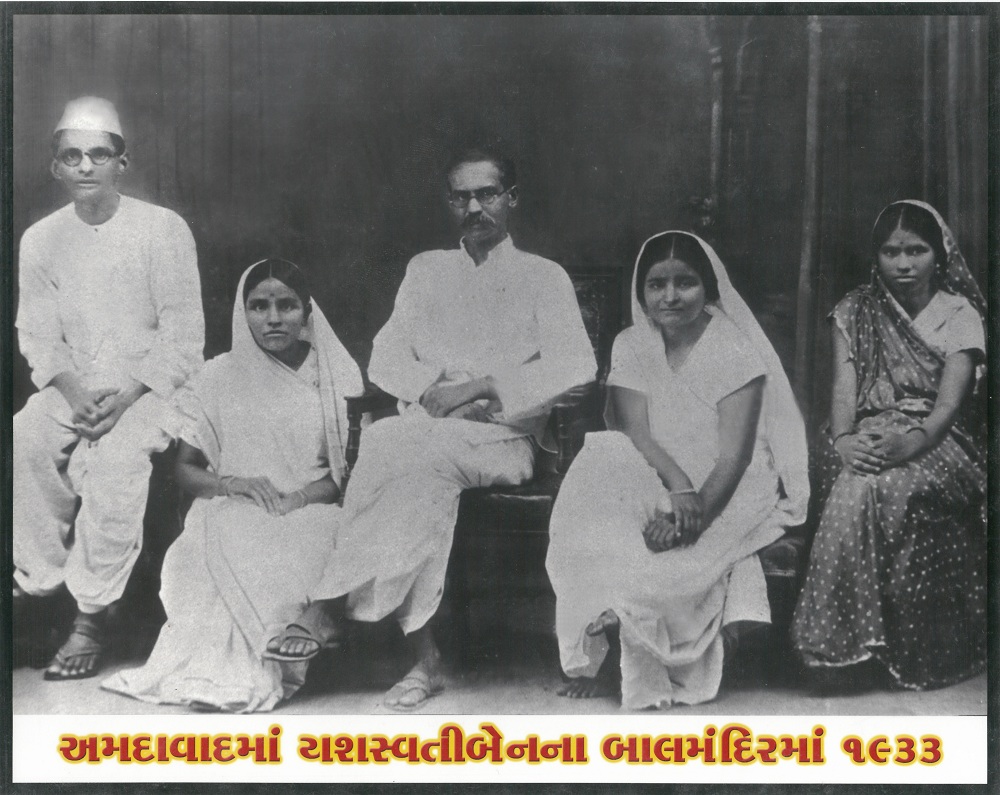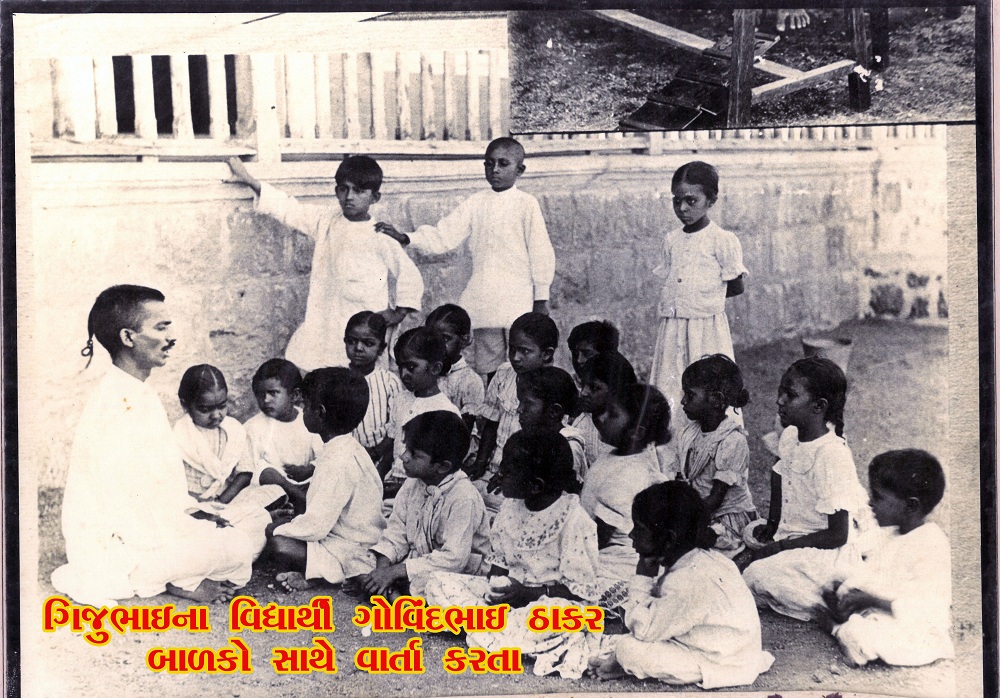Dakshinamurti
From ideas to institutions
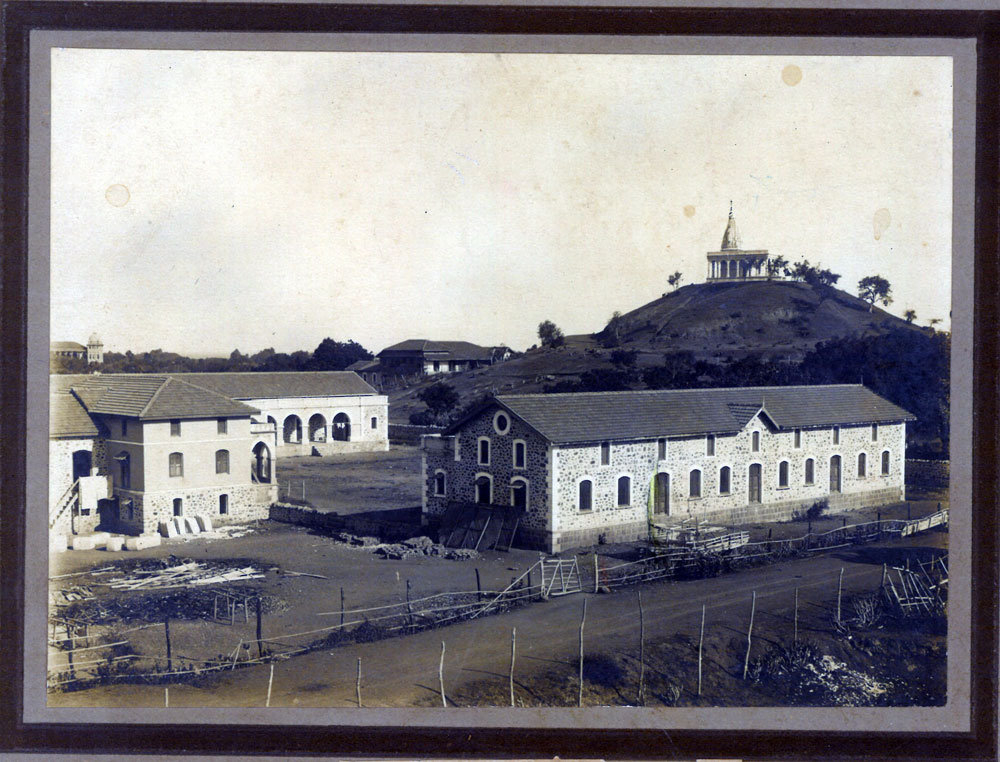
School buildings
Dakshinamurti Balmandir
The decision to start a pre-primary school was taken. A building was identified and toys, and other materials were purchased for the new venture. Announcements were made and admissions were opened.
But the curriculum was yet to be prepared. This was the challenging part.
Gijubhai wrote about this later:
'Looking at that curriculum today there is a sense of joy. At that time there was not much clarity on which educational principles a pre-primary school should be run. In those early days the objective was to blend the methods of kindergarten, partnership etc, and start the best possible Balshala. I had faith in the Montessori method, and others knew that in the future this would be the guiding principle. But at the time there was not enough literature available, so to think of calling the school a Montessori school or to develop a curriculum based entirely on this would not have been acceptable. Also while I believed in the theory and principles, I had yet to apply them in practice. I was not sure what the outcomes would be. Would our children be able to use the equipment? Would a system which originated abroad suit our conditions? There was a lot that I was learning myself, and my experience was still nascent. I understood my responsibility. But I was, and remain, an experimenter at heart. While I was keen to start experiments with the Montessori method, I did not want to be tied to a single approach or method. Thus the initial curriculum was based on a mix of methods and approaches. I was determined to be as objective as possible and not assume any one method to be the "one and only".'
'And that is why the curriculum was a diverse mix of methods and approaches; that is why all kinds of toys were bought. That is also why I could experiment so freely and learn for myself that indeed, the Montessori method could be made to work. The Montessori method has not tied me down, rather it has inspired me to explore new areas of child development and revealed to me new truths.'
And so Gijubhai stepped into the new venture with an experimenter's scientific temper and approach.
The Balshala at Kala Garnala had a grand opening on 1 August 1920.
The first three days
As recorded by Gijubhai
Day 1
At eight o'clock in the morning the motor car came blowing its horn. About thirty or thirty-five children were crammed in. The children were clean. Their clothes were new. Their hair was combed. They had handkerchiefs around the neck, and were wearing shorts and shirts, or long skirts and blouses. This was the dress that had been fixed and had been communicated to the parents. Every child was laughing with the joy of a ride in a motor car.
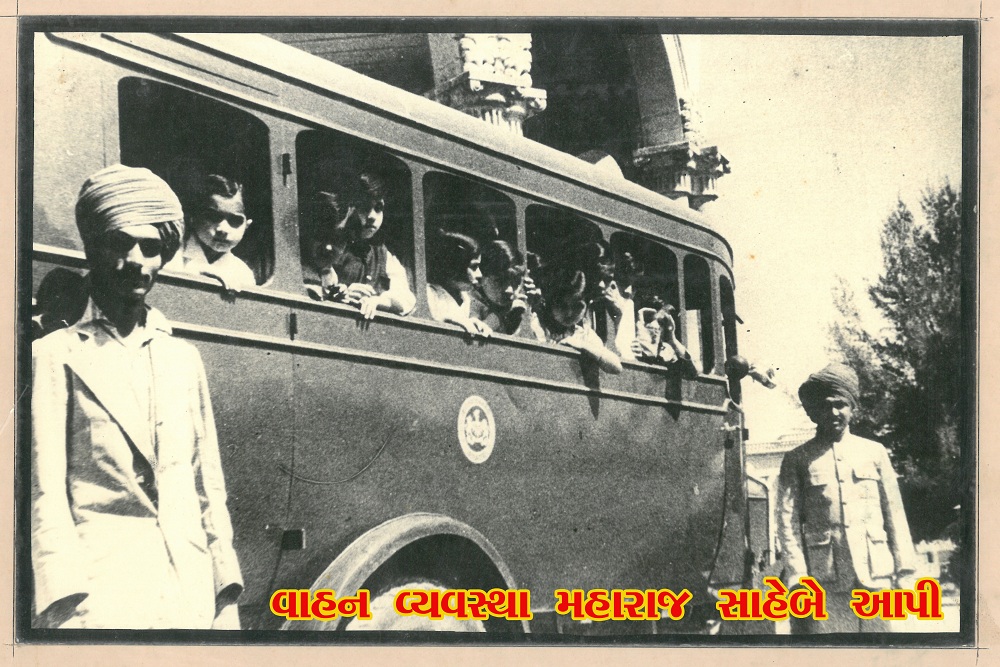
I went forward and helped them out of the car. I was a stranger to them and they were strangers to me. They all walked behind me.
The doors of the balmandir were open. The toys and materials that had been bought and gifted were attractively displayed in the rooms. (The artist Ravishnkar Raval had arranged and decorated the rooms). The balls were on one side, the toy motor cars were on the other side. The toy animals made of metal, enamel and clay were on the third side. On the walls were hung pictures at a height that the children could reach and touch. There were twelve bells and metal containers for sounds. There were books on shelves, and other objects were displayed as they would be in a shop. At the centre of the room was spread a durree, where the children were to sit and work. But where was the Montessori literature and equipment? There were just a few—the shape boxes, the tower and a few others.
The room was crowded with forty children but it was neat and clean. The walls were colourful. There were two small rooms adjoining the main room. There was a front verandah and a big courtyard and garden with a tap and tank.
There were forty liberated children.
Liberated from home, from their lane, from dirt, from conflict, the children swarmed and pounced. They swooped on the toys like locusts, grabbing what they could. Some ran off with the motor cars, some took the ball, some picked up the peacock and parrot artefacts, some snatched the tooters and musical instruments and started playing them. There was tugging and pulling of things from each other. The mechanical cars started cutting across the room as the rubber balls bounced here and there; on child started banging on the door with a wooden stick while another tugged at the rope with bells making them clang loudly. One enterprising trader pulled all the pictures off the walls and started hawking them loudly “who wants to buy these pictures?” In five minutes there was chaos in the room, and a deafening din. In the verandah, some children were taking the blocks out of the bucket and building a house while some others were pulling it down.
I was astounded to watch this unimaginable scene. I could not understand what was happening. I thought “is this the Montessori method? Is this the freedom that Montessori had written about?”
But there was no time for thinking. There was a small tank in the courtyard. A small child fell in. One of my teachers saw this and took him out on time, or else there would have been a dark start to the Balmandir and no one in town would have ever thought of coming here again. With God’s grace we were spared of a disaster. Just then there was another accident. The children reached to take some picture books and the bookshelf and the books fell on them. Fortunately no one was injured.
It was the first day. I did not even know the names of the children. Who should I call, and how? Of the forty there were only a couple that I knew. How was I bring order to this mayhem? From whom shall I take away a toy and from whom should I not? I could not scold any one and punishment was out of the question. I was tied down by my principles.
That day I was comparing with my work in Vinay Mandir. Would these children respond to a ‘notice’? Should I divide them into classes and teach them accordingly? Would I have to take each of the children, and set them right by scaring or scolding them?
This was my direct experience. It was easy, as headmaster, to sit in a chair and give orders; it would not be as easy to give children freedom and teach them. There was no room even for such thoughts and dilemmas. It was the first day; some of the parents had come, as well as some visitors; some had comes with gifts for the children.
Nanabhai and Motabhai had spread the word of the Balmandir even before it started so it was natural that it sbe so.
Motabhai had also come.
Everyone was very satisfied to see the children being so free. ‘What a free school! No one is stopping the children! And there is no sign of beating of fear! So what if they break and destroy things? Gijubhai will not iinterfere! Kudos to Dakshinamurti! Todaythe foundations have been laid for childrn’s freedom!’ These seemed to be the unspoken thought in the minds of the visitors. But my mind was in turmoil. I alone knew ‘there is no Montessori and no freedom in what is happening hre. It is just chaos’.
But what could I do then? The motor car would come back to fetch them at eleven o’clock. I did need to address the children who were being destructive; and that too without using force.
I started a folk game. I had no option. I was in no state to tell a story. Even if I did start one who would listen? They needed to come and sit around me.But no one knew me.
I started to call Chhokra re! (Hey ho children!)
The children responded Ho re!
Chhokra re! Ho re! Chhokra re! Ho re!
Soon the refrain resounded.
Voro aavyo. Shu shu lavyo? (The trader has come. What has he brought?
Dagli lavyo, dubli lavyo. Jena bhaibaap vahala hoy te mane adi jay. (He has brought a dagli and a dubli. All those who love their brother and father come and touch me.)
The children came jumping and skipping to touch me. I ran. The children ran after me. And the game went on.
I added to the game by calling “All those who love their brother and father go and touch….(different things)”.
Here were children and here was a street game that they were familiar with. The toys were forgotten and the children came out into the courtyard to play the game.
I had told the helper Vajibai that as soon as the children came out she should shut the doors of the rooms. I kept the game going until it was eleven o’clock, and the children were happy to go on playing.
The car came at eleven and the helper put them on.
The first day was over. After three hours I breathed a huge sigh of relief.
Putting aside the confusion and discomfort I decided that big changes needed to be made. And the Montessori equipment needed to be organised right away.
I called Vajibai and got her to collect all the things that were strewn here and there. Luckily nothing was missing, but the things had certainly travelled a long way from their designated places.
I went home and had lunch. I started thinking what changes could be made: no toys on display, or to be given only when it was time for play; not to open the doors immediately; to get to know the name of every child; start stories and music; put out whatever Montessori equipment we had for use; keep the books in the bottom shelf…so many ideas and thoughts.
I remembered the objectives that we had listed in the leaflet to announce the Balmandir and the scenes from the morning swam before my eyes. My mind started debating: Should the methodology be revisited? What should the teacher be like? What should the environment be like? I reread the pages about order and revisited the use of the equipment and gathered up courage for the next day.
In th evening I went back to the Balmandir.
At that time this was housed in Ratilal Modi’s building at Kala Garnala, I hid away the toys and put away the rubber snake and cleared the room. I placed the Montessori equipment at a lower level. I spread a large durree in the room. I decided the place for storytelling.I called for a harmonium and kept it in the room. I arranged the letter cut-outs. I worked till late in the night. I also got made tags for children to wear around the neck with their name and address. It was decided that the name tag would be given to the parent at the time of the child’s admission.
The night passed and it was morning.
Day 2
The motor car drove up and the flowerlike children got down; they ran towards the room. The room was shut! They went here and there. I called them and started a game.
The children liked the game. They came close to me. Then I opened the door, and they pushed and shoved their way in but once inside they were taken aback. They searched but could not fine the toy motor cars; I had kept the balls carefully and the tooters and hooters were out of sight.
I gave them the Montessori equipment (dattani peti) and showed them how to match the shapes; I gave them the tower and the steps.
But how long could that last?
Some children played with the shapes for a while, some tried the tower and left it scattered there, some made a shelf from the ladder.
But a few of the children started working with focus. Bhagwanlal, Popatlal, Kanaiyalal and Sonibhai were trying to build a bungalow. It was quite out of form but they were involved, concentrating and happy with what they were doing.
Little Taraben started to learn letters by tracing the sandpaper forms. I could not show her how to lightly trace them, and her fingers started bleeding by rubbing hard on the rough paper.
In the nest room, some children were playing a game of identifying and matching letters. I started the game by asking them to bring a letter like K or G and then moved away. But then they got confused and stopped the game. The little trader from yesterday once again started his round of hawking pictures.
In the same room I had closed my eyes and was showing how to build a tower. Someone came and pressed my eyes hard; some others climbed onto me and started jumping. I carefully got myself free.
The noise had increased in the room. I too joined the din. I yelled “Jump” and the children jumped and jumped. I called “dance’ and they danced. I called “laugh loudly” and they laughed. I shouted “shout” and they shouted “run” and they ran.
I came out of the room. I thought 'Even today things are not quite right.' I rang the bell, but no one came. I started yesterday's game of Chhokra re. They all swarmed and clung to me. We played and played. Finally I said “All those who love their brother and father follow me and sit where I sit.”
I walked ahead and the children followed. I crossed two rooms and went and sat in the third room. I was very calm and quiet. The children were also silent. As I had instructed earlier, once we were in the room, the door was closed. I had deliberately not kept a way for the children to exit.
Speaking softly I started a story: Once there was a crow and there was a myna...
The children got very interested. I knew that stories are a magic wand. The children were listening, still as statues. The story continued. Their eyes were locked with mine. They were no longer restless. They were repeating with me, some in their heads, and some aloud, the refrain in the story.
The story was the key to order.
Then, as we had planned earlier, the harmonium started to play. The children’s ears perked up. The children listened to the music. They were happy. (I have written extensively elsewhere about my experiments with music). But that day the children listened to music for the first time. Some even got interested in it.
The children asked for folk games again. Many had learned my name. Today I was in front of them. I was playing with them, I was jumping with them and I was with them for music. They recognised me. They were beginning to support me.
We started a game of seven claps. There was a lot of running and laughter and fun. Some of the younger children were playing with the gilli and danda. Others were watching the older children play. They sweat was dripping. The joy of the game increased their closeness to me. We were becoming friends. I was also beginning to know the children by name.
The car came and it was time to go. I went to the car and bid them goodbye. The children called me Gijubhai and wished me good bye. I had introduced this rite of namaskar vidhi from the first days. The children liked it; rather we liked each other and so we all liked this small ritual. With time this became a part of daily behaviour. The children would greet each other with a namaskar wherever and whenever they met. Even if a child was sitting for defecation and I happened to be passing by, they would greet me with 'Gijubhai je je' or namaskar. The parents were happy with this habit. They were seeing the difference.
The car left. Vaji and I started putting back the equipment. Today it was not as difficult. Today the seeds of hope were sprouting. I felt that things had gone somewhat better that day. But there was still much remaining--working with equipment, silence, working independently without depending on me. How could the work proceed without using tactics and attractions? In short, from the Montessori viewpoint, everything remained to be resolved.
Yes, one thing was real. The children from the town who came here were free from the strictness of school, from the dirt and darkness of school. There was a spacious room for them; there was cleanliness, there was a garden to play in, there were stories to listen to and there was music. There was no one who would scold or force them to study. This was a place of joy for the children. The children used to reach the pick-up point on time and they had their handkerchiefs properly tied. They used to get off happily and start playing immediately. There was disorder, there was noise, the equipment was not properly arranged; for all this I was responsible.
Today had gone relatively well. I went home and started thinking about preparations for the third day. There were less hours of work here as compared to what I had as the head of Vinay Mandir, but I experienced many more times the worry that I had there.
From where would I get the equipment? How would the true order and development visualised by Montessori be achieved? I would need an assistant. Music, stories and games alone were not enough. All these questions came to me.
Lost in these thoughts, I fell asleep; and the third day dawned.
Day 3
The car arrived, the children got off. They were waiting for the door of the room to be opened. I had spread a durree in the verandah. I was sitting there by myself. My eyes were shut and I was reciting a prayer. Some children were watching me, a few came and sat down, others were running around like squirrels.
My prayer did not name a god. For me, the children were my gods. My prayer was for order, peace and quiet.
The children came closer and slowly joined in. The children too were not praying to a god and neither was I pushing them to do. The intent of the prayer was to sit with them quietly with eyes closed and be together.
When Harshadrai was lagging behind in reciting a line, and then repeated it after the rest, I also joined in the laughter.
The prayer helped in cultivating the habit of sitting still. The children got closer to me. It also created the necessary calm and focus before starting other work.
The children were prone to using objects carelessly—dropping and throwing, or kicking things. I tried to draw their attention to this by demonstrating. I made them sit. I picked up a book and held it carefully, I put it down gently and said “there should be no rustling, see how it should be picked up and read”. Then I asked “who wants to try this? Put up your hand.” Then I called the names and, turn by turn, the children picked up and put down things. I said “this is how we will do it every day.” Then I said “now each of you can pick up what you want to play with.” The children immediately ran to get what they wanted. I was observing. I saw that they were now being careful about picking up and putting down things. But they were disorderly about rushing to get the things. I showed them how to do this in an orderly way. And after that they did the same.
In the same way I demonstrated how to behave when going in and out, sitting down and getting up, and moving around. These small habits and behaviour were essential to social life, and children also like and respond well a code of conduct. An environment of culture and order is essential nutrition for their development and they imbibe this well if it is offered.
Thus a code of conduct developed in the Balmandir with regard to everyday actions and behaviour. Once an environment of order was established, it begat more order. And so the first week ended.
Translated from the original Gujarati by Mamata Pandya
Source: Ramnarayan Nagardas Pathak Bal Shikshan Praneta Gijubhai
First published November 1957, Sanskar Sahitya Mandir, Bhavnagar
Balshala to Balmandir on the hill
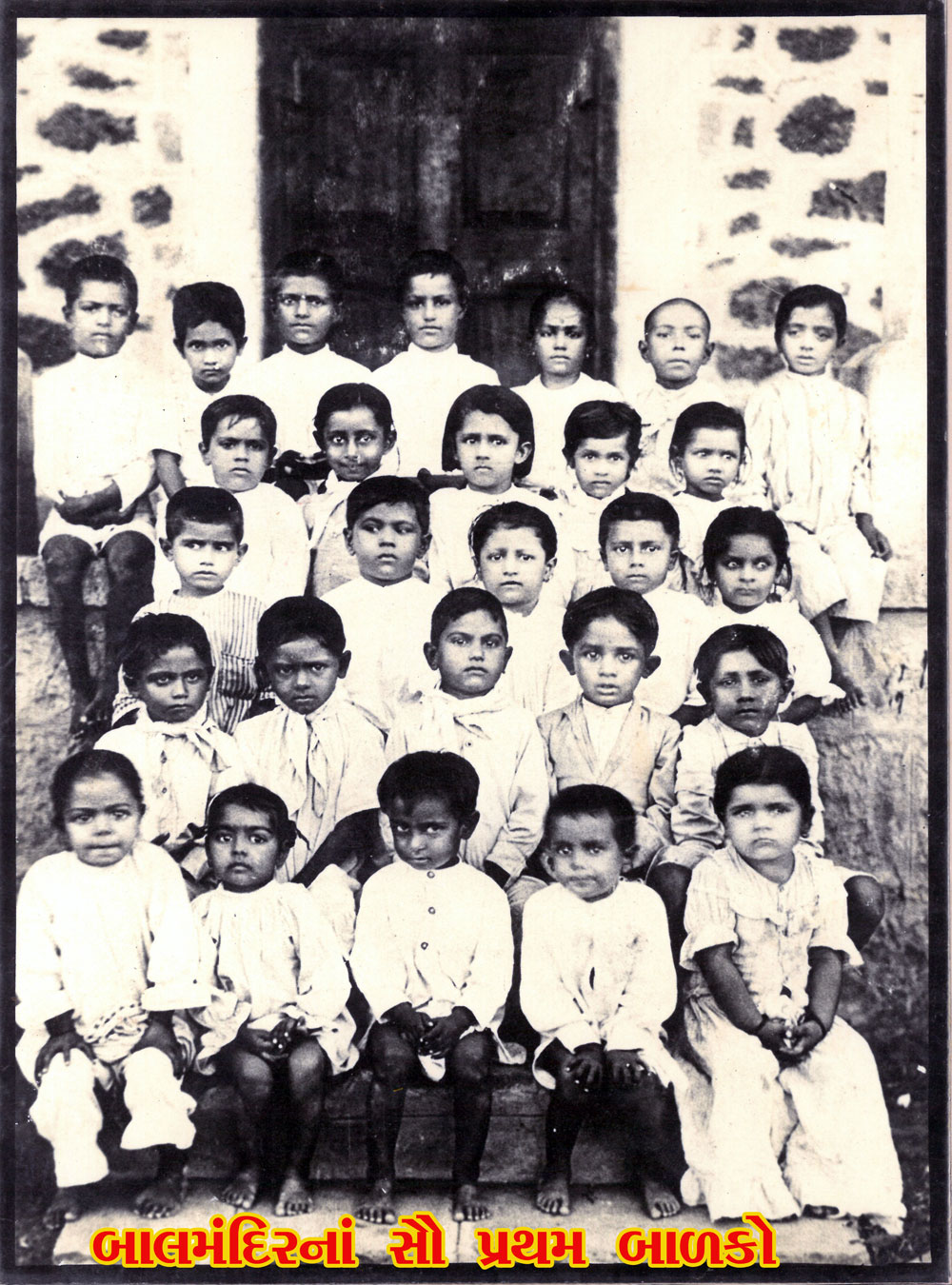
The first batch of Balmandir children 1921-22
As the word of the new Balshala spread and number of students increased the three room house at Kala Garnala could not accommodate the children and the many activities of the Balshala.
The trustees explored possibilities of acquiring land and constructing a bigger building. The search ended with the perfect site—the small hill close to the hill on which the Takhteshwar Mahadev temple stood. The area around it was all grass fields and thorny scrubland, but view from the top was splendid. The foundation for the building was laid. A close friend and well-wisher Sheth Hiralal Amrutlal Shah donated a sum of Rs 20,000/- towards the construction of the building.
The Dakshinamurti Balmandir. on the hill (Tekri nu Balmandir) was opened by Kasturba Gandhi on 4 May 1922.
One of Gijubhai's colleagues in the Vinay Mandir, Vitthalrai Avasthi wrote:
Both of us together decided to give the name Balmandir to the Balshala. This was because we teachers were not to beat, scold or threaten the children who came there. Rather they were to remain impartial and simply guide the children with affection, respect and compassion. So we named it Balmandir.
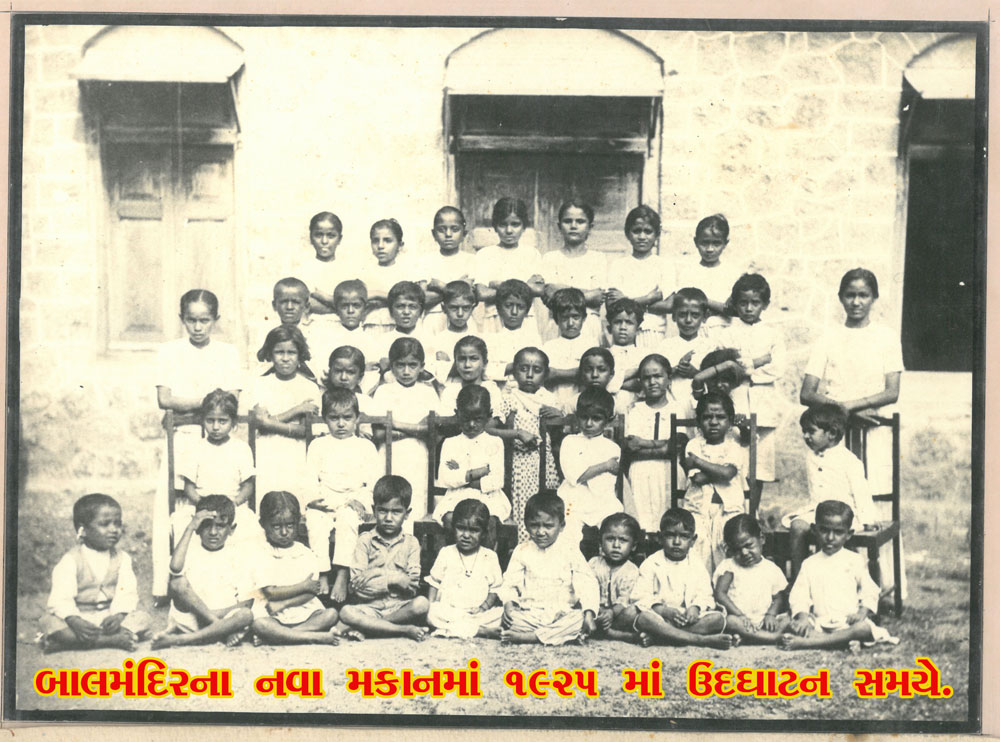
Inauguration of the new Balmandir building on the hill 1922
A day in the Balmandir

In the forecourt of the Balmandir
Standing on the steps at the top of the Balmandir hill, Gijubhai watches the children as they float up like butterflies and welcomes them affectionately. With two hands folded together in a namaskar, they greet each other gently and joyously. Gijubhai examines each child’s hands, nails, eyes, ears, hair and teeth. Once in the room, the children arrange themselves in rows, facing Gijubhai, and there is talk about homes. Gijubhai peeps into the children’s hearts. While the questions are ordinary and answers simple, they churn his heart; they give him a sense of each child’s context and he searches for appropriate ways to go ahead. With a mother’s instincts Gijubhai identifies the unopened, crushed, trampled and tampered psyches of the children; he envelopes them into his warmth and creates conditions for them to blossom and bloom. Gijubhai’s talks are like a magic wand that could reach deep into the mind and heart of a child to awaken and unveils hidden treasures.
The children file into the music room and settle down. The music teacher Chunibhai sits with the dilruba, flanked on one side by the table player and by Gijubhai on the other. The atmosphere is calm and quiet. Gijubhai sits erect. He places his hands on his knees and the children follow suit.
Gijubhai would start a song. He sang with full immersion, using his hands, and facial expressions to bring the words alive. Soon the children would join in the singing. The the children would lead; after them it was the urn of Chunbhai and Monghiben. Then back to Gijubhai for a favourite song. Everyone wold be totally engrossed in the music; there was no distinction between listener and singer. Then Gijubhai would lead a march. Carrying a stick on his shoulder he would lead the way around the room and the children would follow singing favourite verses and rhymes. There would be mock sword fights with the sticks.
And then he would announce “Music is over.” Immediately the children would put down their sticks and move to the rooms for games.
In the equipment room Gijubhai would walk softly and bring the mats, he would bring and keep the equipment on the mats. The he would start using the equipment and encourage the children to do the same. Once he started he would withdraw and observe then closely. It was as if he was not in the room, but just the children, each engrossed in their tasks. Gijubhai had an incredible gift of becoming invisible behind the personalities of the children. The children felt that they were free to ‘play’ as they liked with these ‘toys’.
Gijubhai started experiments with sensory activities, language development, mathematics with a scientific rigour and gradually the impact could be seen in the children.
Then of course there were the stories. Gijubhai made every character come alive; so much so that the children were eager to enact these characters themselves. Stories would transform effortlessly into plays. On Sunday the balmandir would resound with the sound of the drum and cymbals, dialogues and songs and much laughter as the plays were joyfully enacted on a stage, until the curtains were drawn shut to the applause of a full-house audience of teachers and parents.
While there was much to feed the mind, food for the body was considered no less important. Gijubhai introduced the nasta (snack) time as an important component of the curriculum. The small rituals introduced for this period, including the few moments of silence and prayer, were important lessons in discipline, order, proper food habits and mealtime etiquette.
The cool time of early morning was kept for gardening. With small implements like spades, diggers, buckets, watering cans the children worked with the soil and plants. As Gijubhai observed the children planting, noticing new growth, admiring fresh flowers and butterflies, he was equally observing how each child was growing and flowering in communion with the plants. The gardener was reaping double rewards.
At the end of the day the vehicles would come to take the children back. The cymbals would announce that it was time to go. Gijubhai would be back on the top step where had welcomed the children in the morning; now he would bid them goodbye. The children would wish him with bowed heads and folded hands “namaskar Gijubhai” “Gijubhai namaskar”. Gijubhai would reciprocate the same way.
Having bid the children goodbye for the day, Gijubhai would sit in the balmandir veranda with his colleagues. They would exchange thoughts about the day—the work, their observations, and their experiences. These would be discussed, and observations on seemingly routine tasks and children’s responses and behaviours would be analysed. Based on these, plans for the next day be reviewed.
Based on Ramnarayan Nagardas Pathak Bal Shikshan Praneta Gijubhai
Translated from the original Gujarati by Mamata Pandya
Balmandir Activities
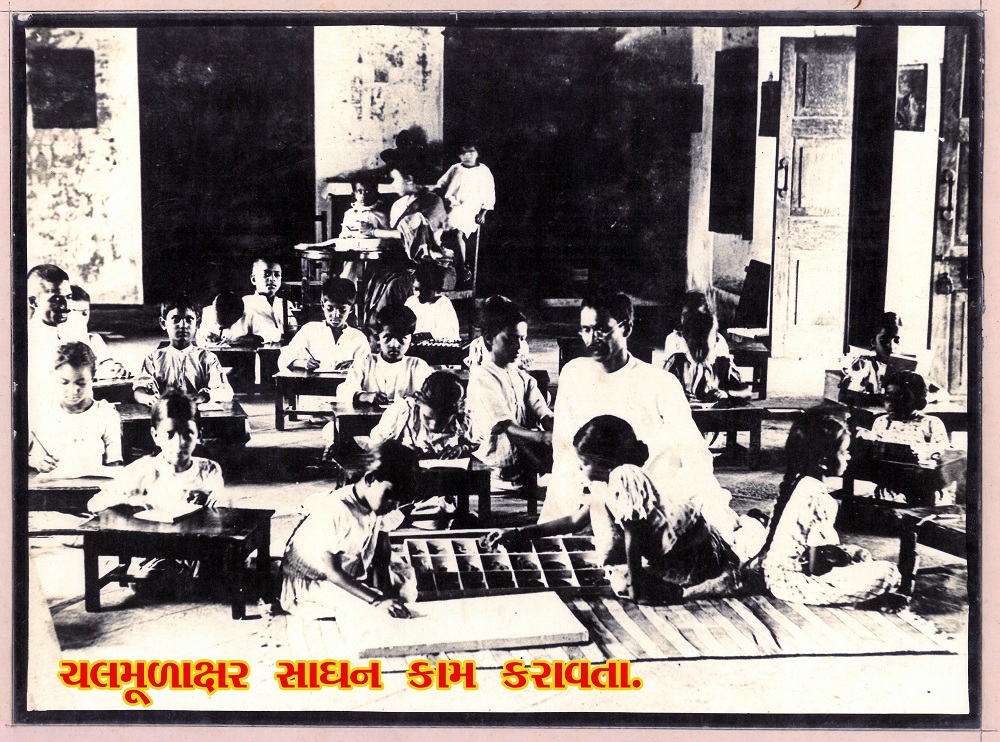
Working with chalmoolakshar equipment
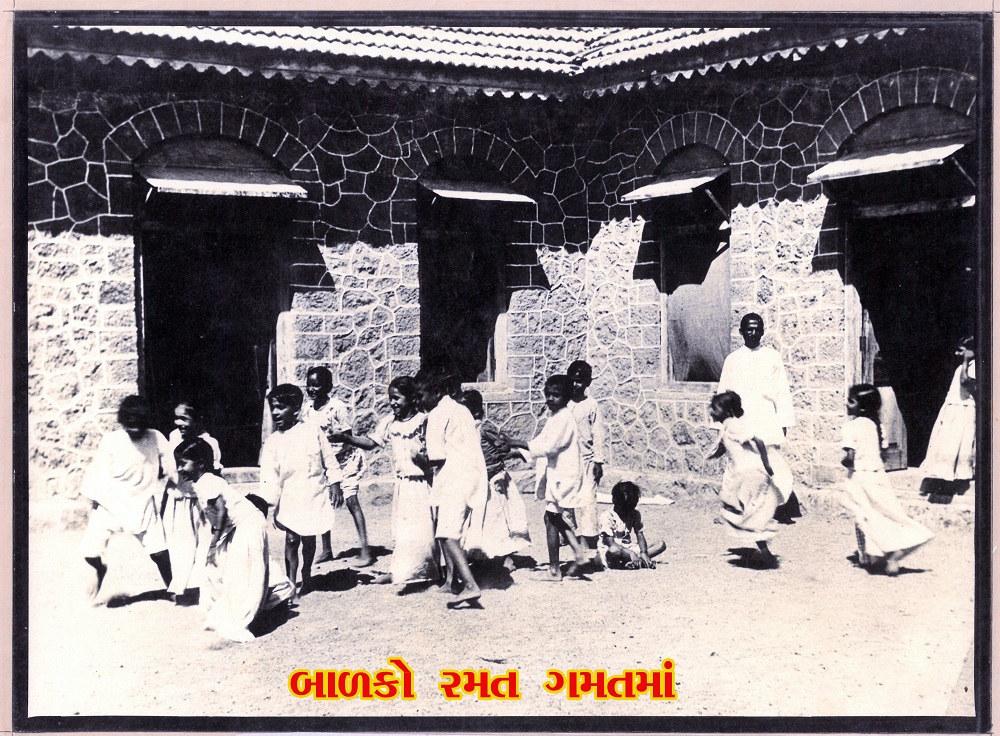
Playtime
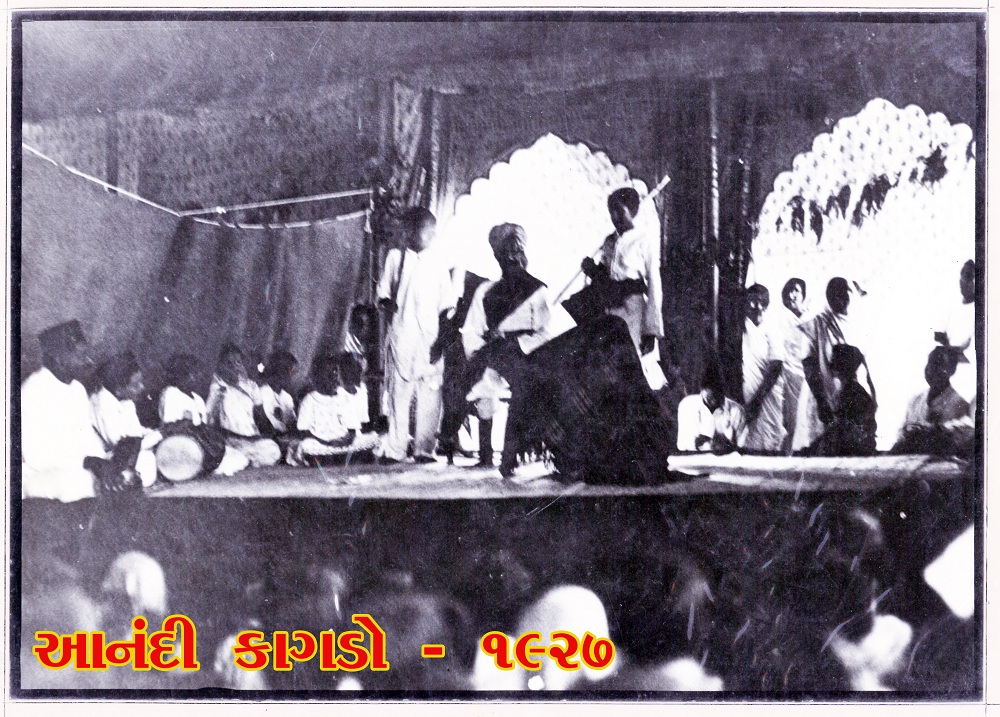
Performance of Ananadi Kagdo (The Merry Crow) 1927
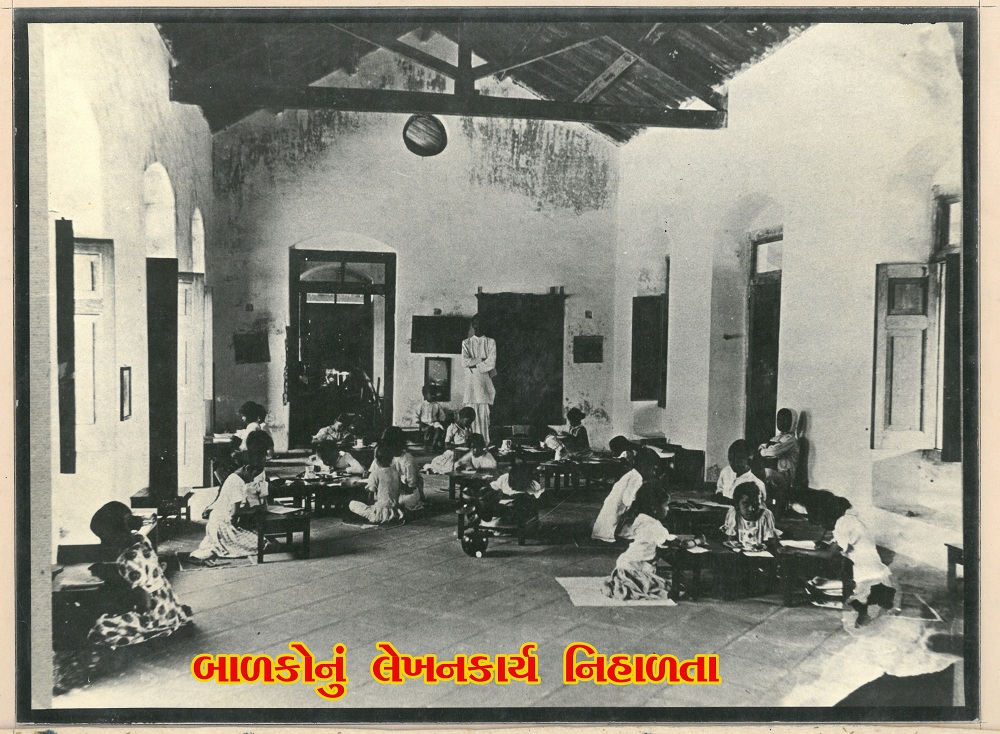
Observing children as they write

Music
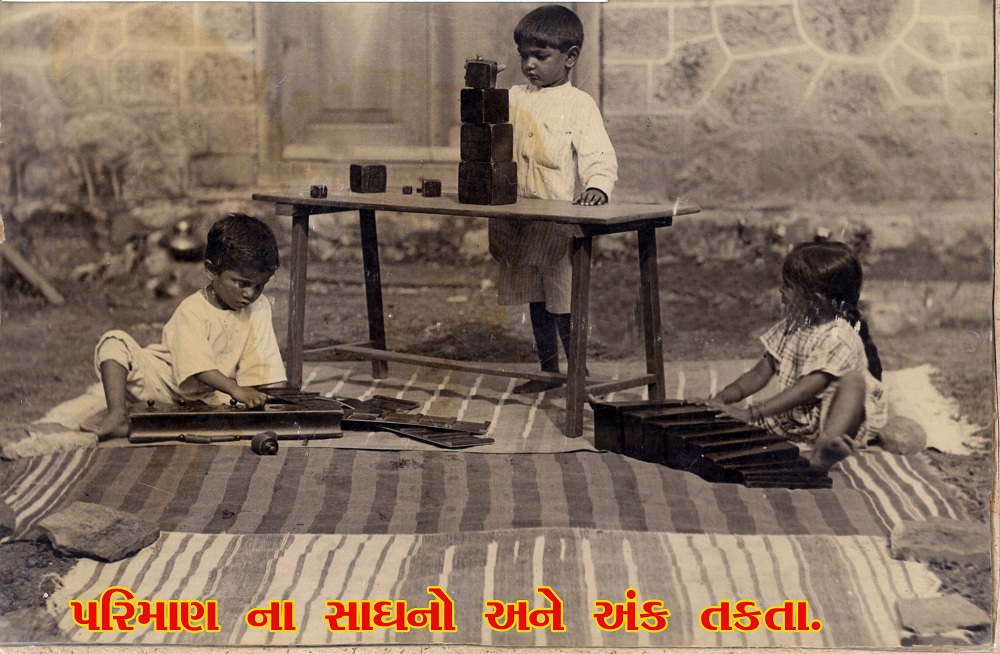
Children working with estimation and measurement equipment
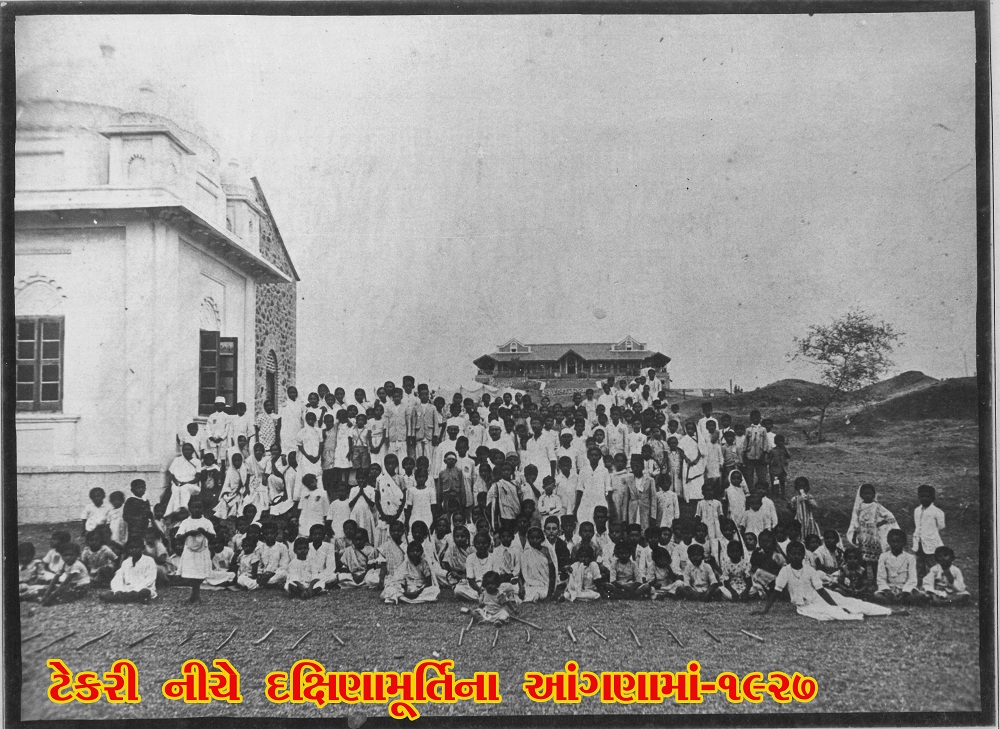
At the foot of the Dakshinamurti hill, 1927
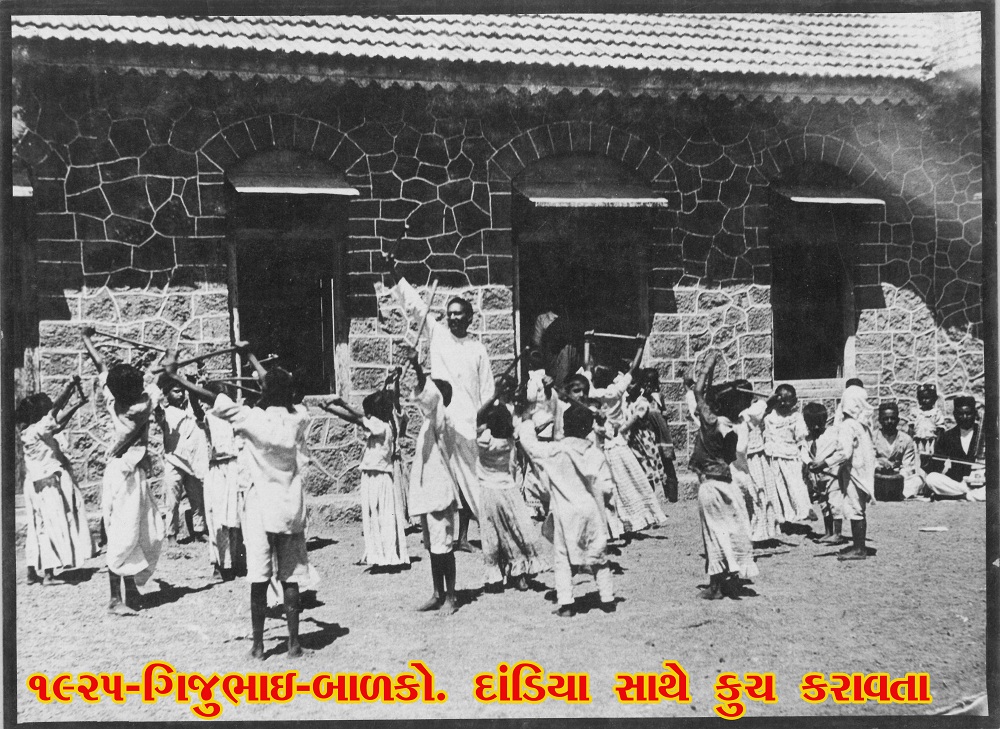
Exercise with sticks 1925
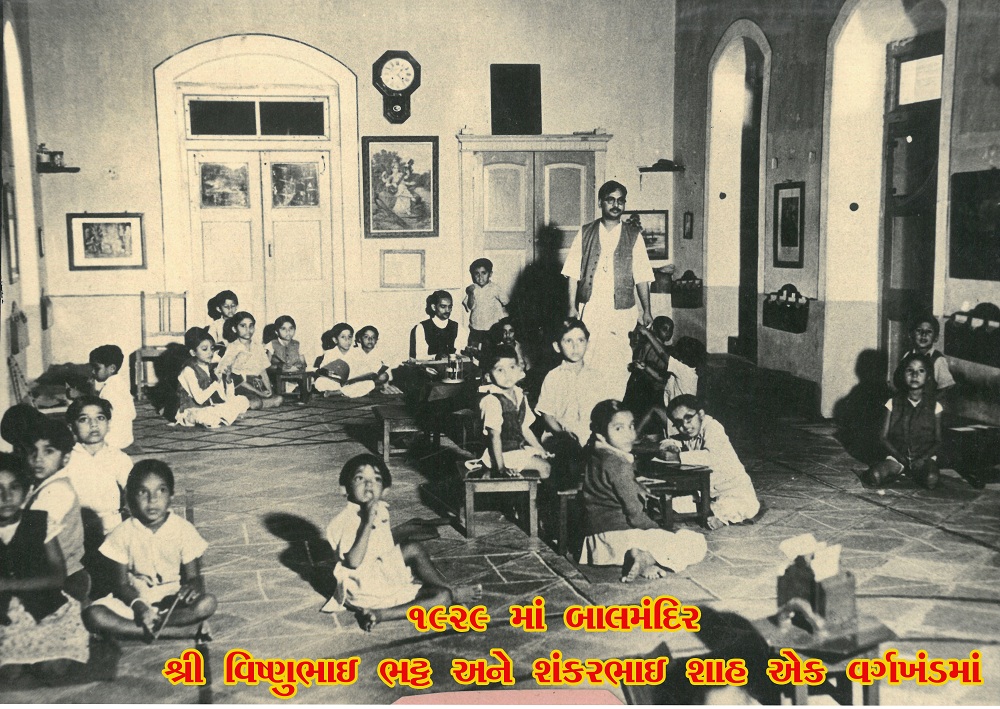
Vishnubhai Bhatt and Shankarlal Shah in a balmandir classroom 192
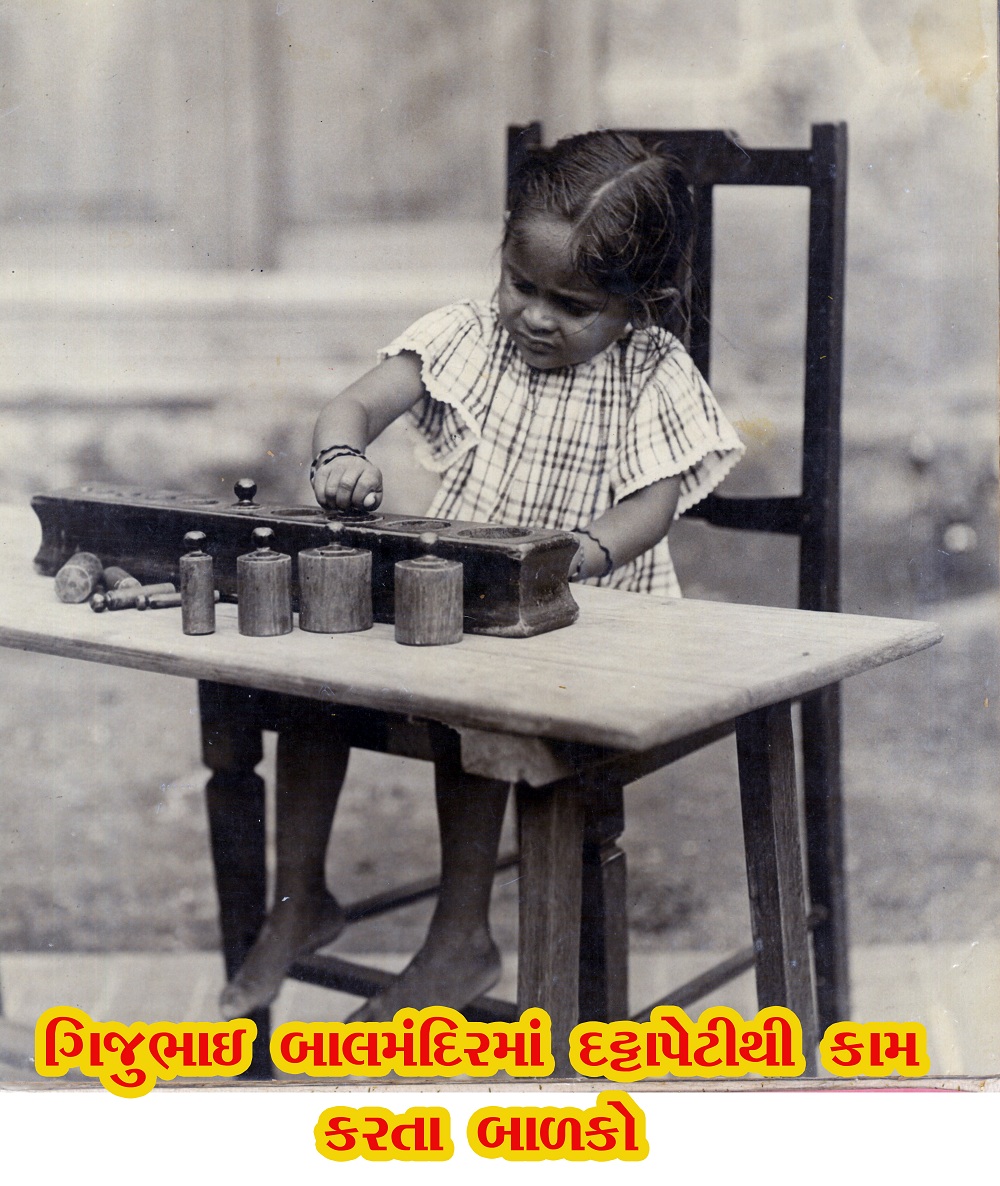
Child working with dattapeti

Children working with sand letters
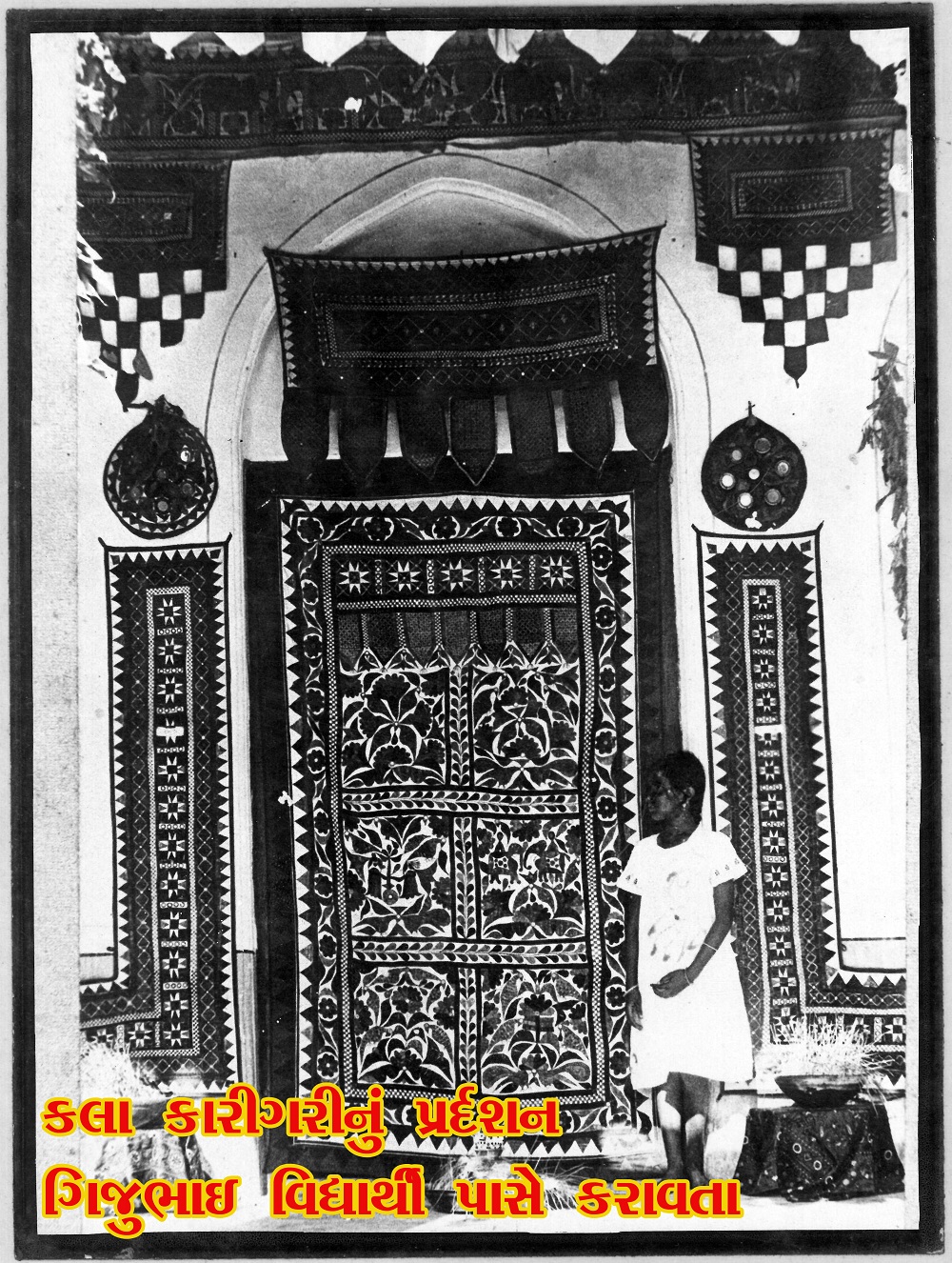
Art and craft exhibition put up by students
आचार संहिता
Aachar Samhita For the parents and teachers of Balmandir
Author: Gijubhai Badheka
Language: Gujarati
Format: PDF
Code of Conduct
Aachaar Sanhita For the parents and teachers of Balmandir
Author: Gijubhai Badheka
Language: English
Format: PDF
Gijubhai's core cadre
Manubhai Morarji Bhatt
As the disorder and din settled in the new Balshala, an atmosphere of order and calm set in. Parents were amazed at the change in their children, and as the word spread, the number of children increased. It was starting to become difficult to manage everything and also give personal attention to each child.
Gijubhai was in need of a helper. As it happened, one morning when Gijubhai was sitting in his house, a young man arrived and stood before him with hands folded in a namaskar. He was interested in child education, and was eager to learn more. He addressed Gijubhai firmly, a soldier would: “Gijubhai I want to work under your hands.” Gijubhai replied like a General would: “Come on then.”
And so joined the first soldier in the cadre of child-centred education. His manewas Manubhai Morarji Bhatt.
Gijubhai put him immediately to work. His first challenge was Montessori’s principle of ‘freedom’.
There were a few six year old students in the Balshala and also a couple of mentally challenged learners. Gijubhai made a separate group of these children and assigned them to Manubhai.
As the school building was on the main road, and there was a lot of traffic, every time a motor car passed some children would rush out to see creating a lot of disturbance. Manubhai came to Gijubhai and asked what he should do about these children, and whether he should punish them.
Gijubhai was sitting with the other children. He told Manubhai “Use your brain”.
So began Manubhai’s training. He started thinking about the right approach to tackle issues. He started looking for ways in which he could deal with children while respecting their freedom and individuality.And in this search lay his practical training.
But Gijubhai was conscious that dealing with children should not be only by instinct. He was particular his teachers should understand and then internalise the theory behind the Montessori principles. For this he spent an hour every evening in discussion and debate about questions and issues.
For example while during the class he told Manubhai to handle the situation, the same evening he raised and debated the issue of beating and punishment. He explained that once they started punishing children, they would get used to this and the teachers would have to keep increasing the punishments. He suggested that if the children liked to see the motor cars they should let them do this, until the children themselves would tire of this and get back to work.
Ramnarayan Nagardas Pathak Bal Shikshan Praneta Gijubhai
Narmadaben Raval
Narmadaben was the sister of the well-known artist Ravishankar Raval. She came seeking joy in the company of children, and eager to learn about Montessori’s principles of child development. Gijubhai started her training by simply asking her to observe the children. She did this for months, and from her observations deduced not only the principles and practices, but also the issues and challenges.
One example that she later recalled: 'There was child. It would not look at the Balmandir, but just sit on the steps. Gijubhai used to observe the child. I used to get bothered just observing the child doing nothing. I felt that we should give it something to do. I used to argue with Gijubhai about what to do. But he was clear that the Montessori method demanded that they be patient. He said that I should continue to observe. This continued for six months. The child would come to school but sit on the steps. Finally, one day it came into the room, and immediately picked up the chalk and slate and started writing letters. Gjubhai was delighted. He sent the slate to the photographer's and got a picture taken. And he told me "today I have got a key to the Montessori method in my hand".'
Pratham Swayamsfurit Sarjan Narmadaben Raval in Smarananjali
Monghiben Badheka
One day Gijubhai called for his niece Monghiben who was child widow. She had only a basic education, and very little exposure to the outside world. Gijubhai gave her the support and confidence to become one of his trusted comrade-in-arms. He started by inviting her to share songs and stories, which entranced the children and the elders. Monghiben learned Bengali and began writing for children. She shared many of Gijubhai’s duties and was a support to him right till the end.
In a tribute to Gijubhai written after he passed away Monghiben reminisced how Gijubhai told her, on her first day at the Balmandir, that once they climbed the steps up to the Balmandir she should completely forget that they were uncle and niece; they just had to work for the Balmandir. She also remembered how once when they were walking in Victoria Park Gijubhai said “Monghi, shall I tell you a secret? Don’t tell anyone else.” He continued “Once this institution completes 20 years, I am going to leave and go off to the Himalayas. I have done a lot of tis work, but this will not give me atma darshan (enlightenment of the soul). I want to spend the last part of my life in the Himalayas; it is my wish to set up an ashram there. Will you come?”
Monghiben also reminisced about how Gijubhai got people to work without giving orders or keeping himself aloof from the work. She recalled that when it was time for the Shiksham Parika to be posted, he would be with the team, putting the wrappers and pasting the stamps till two in the night, all the while chatting and joking.
Shri Gijubhai Monghiben Badheka in Smarananjali
Taraben Modak
Taraben was already the principal of the Female Training College in Rajkot. One of the few women graduates of that time, she already held a prestigious post and had some administrative experience. As it had happened in the case of Gijubhai himself, it was Taraben’s quest for a better education for her daughter that brought her to Dakshinamurti, which became her karmabhoomi for the rest of her life.
In her own words: 'It was a blessed moment in my life that led me to set footin Bhavnagar and to see balmandir on the hill.'
At that time I was not thinking about myself. I was only concerned about my daughter’s education. I was thinking about educational methods. Little did I imagine at that time that the head of this balmandir was to become my life guru; that it was from here that would determine the course of my life.
I went to Bhavnagar. My only joythen was that my daughter had found a good school. I was also happy that I wold get an opportunity to study about education, and that I would have the presence of pujya Nanabhai and Gijubhai.
I started studying the principles of education, got involved in discussions. These were complex subjects and my rational Maharashtrian mind would not accept things only for their emotional appeal. So there was a lot of reading, thinking and debate day after day.
I came to see the relevance of Montessori’s educational principles extending to every aspect of life. I began to see the vastness of the principles. Many of my confused ideas became clear; incomplete thoughts became complete; I moved from the superficial, to thinking in depth.
Pujya Gijubhai believed that it was Montessori’s principles alone, if understood properly, which could change a human being. He was a devoted disciple of Montessori and he also made me one. Driven by this passion, we started rapidly expanding the work of the Balmandir. Gijubhai not only infected me with his zeal, he gave me my life’s aim and mission.’
Maara Guru Taraben Modak in Smarananjali
Blossoming of the Balmandirs
Gijubhai was aware that a single model Balmandir in Bhavnagar would not be enough to spread the movement of child-centred education. As more trainees graduated from the Adhyapan Mandir he encouraged them to set up balmandirs in the towns that they came from, promising his support and guidance. As a result balmandirs started to be opened across Gujarat—in Rajkot, Porbander, Jamnagar, Surendranagar, Nadiad, Patan, Ahmedabad, Indore, and Dadar. Gijubhai would personally visit these at least once a year, and provided continuous guidance through his letters. When the Kutch Lohana Kelavni Mandal requested Gijubhai’s guidance for their fifty schools, Gijubhai himself went to Kutch and help them reorganise the curriculum and practice. He also ran a training programme for the teachers.
As the President of the Bal Sammelans (Children's Summits) in Patan, and then in Karachi he shared his thinking and practice with a wide audience reaching many other parts of the country.
